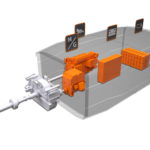Wärtsilä has received its first order for the recently introduced product »HY«, a hybrid power module. Talking to HANSA about this and automation technologies, the group expects this to be an option for more and more vessel sizes and types. By Michael Meyer
The »HY« combines technologies from different segments: engines, an energy storage system, and power electronics. In order to improve operations[ds_preview] and reduce emissions and maintenance, the latter helps to produce the energy from the combustion engine more efficient, Wärtsiläs R&D expert for automation, Ingve Sorfonn, explains to HANSA.
Conventional performance control inside the engine room is limited to each individual component. The Finnish company sees »a notable trend« in the marine sector towards hybrid propulsion solutions, which are anticipated to represent a »significant percentage« of all contracted ships within the coming ten years.
The recent contract has been signed with Italy-based Rimorchiatori Riuniti, which is said to be the biggest owner and operator of tugs in the Mediterranean Sea region.
The power module, which the Finnish technology giant calls »a new industry benchmark in marine hybrid propulsion«, will be dedicated to a project for a new 80 TBP harbour tug, making it the first ever project to feature propulsion based on this Wärtsilä technology.
»It represents the newest and most advanced level of integration related to hybrid technology for marine applications. Specific operational features embedded in the control logic of the unit will enhance operational safety and environmental considerations when operating in waters adjacent to heavily populated areas«, Wärtsilä says. During development of the »HY«, the company put emphasis on a configuration, which is based not only on the maximum power demand, but also on specific operational profiles and the time factor. The dimensioning approach »evolves from power-based to energy-based«.
»We are proud to be the first in the industry to embrace this highly advanced hybrid technology. It will provide operational flexibility, added safety, and of course, environmental sustainability,« Raffaello Corradi, Group Technical Director at Rimorchiatori Riuniti, is quoted.
The Wärtsilä HY features a new integrated energy optimisation system (EOS). It has been specifically designed for hybrid applications. Wärtsilä emphasizes that it creates »excellent interaction« with the ship’s onboard systems to enable enhanced operability and greater predictability.
The energy storage is supposed to lead to an instant ship readiness without the need to wait for the engines to warm-up. At low loads and if selected by the operator, the power is expected to be supplied exclusively by the energy storage system until it reaches a pre-set minimum state of charge. It is recharged when the engine takes over the power supply. As well, both can supply power at the same time.
For Sorfonn it is clear that the shipping industry will see more and more vessels equipped with this kind of technology: »The development of battery technology in terms of power and size is going on. In the future, this will be an option for more and more vessel sizes and types and types of operation.« He thinks, energy storage systems will definitely improve, and they will be used more and more for vessel efficiency. »We will see much more advanced navigational systems, we are heading to a future with partly autonomous systems,« Sorfonn adds.
Referring to the question, if there is any end to development for automation technology, he is sure: »No, we have said that too many times and every time it proved wrong. Security and safety will always be critical points. But they will improve, so we can use the technology much more extensivly than today.« However, whether it will be accepted as a practical operation, »we don’t know today. The technology will not be a barrier.«
For the new »HY«, bigger vessel segments like a large tanker will not be the target for the moment, because a very huge energy storage would be needed. This is expensive and takes a lot of space and it is not very practicable. But, Sorfonn adds, »What we see is that in all types of vessels with more flexible operations, you can reach significant efficiency gains. Examples are ferries, tugs, offshore vessels, generally coastal vessels.«
Wärtsilä started the development in automation technologies many years ago. Since 2012, the group had several pilot vessels operating with different hybrid systems and also full electrical projects. »So we can combine the different applications, we can either operate an engine, a battery or a combination. With this experience we were and are able to optimize the technology.«
Accordingly, the »HY« will have dedicated versions for each category of vessels. While the first versions being made available will be designed for tugs and medium sized ferries, Wärtsilä also sees huge potential in other types of vessels as well. Classification society Lloyds Register (LR) has already issued an Approval in Principle (AIP) certificate for the »HY«. The certificate is based on technical material and safety analyses, concerning normal operation of the system and of risk scenarios. LR’s Marine & Offshore Director, Nick Brown commented: »LR is focused on supporting the safe and effective introduction of new technologies offering the potential solutions, and hybrid technology is one of those.«
The »HY« is said to provide benefits through increased operational efficiency and flexibility, resulting in lower fuel consumption, reduced emissions, and improved vessel performance. When operating in »Green Mode« zero emissions can be achieved. According to Wärtsilä, smokeless operation is also achievable at all load points and in all operating modes, thanks to a new automation procedure. Furthermore, the expected reduction in engine operating hours could lower maintenance requirements and extend the intervals between overhauls, while the higher level of redundancy could increase safety.
Michael Meyer






















